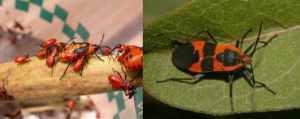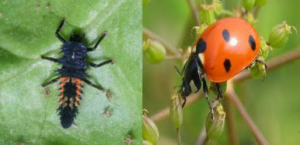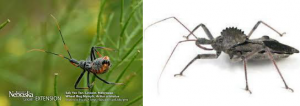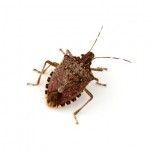READY TO GET STARTED?
REQUEST A FREE ESTIMATE
Fill out the form below or call (888) 466-7849 for a free, no-obligation estimate.
Spring is a time when everything comes to life, blooming into an array of lovely colors. You’ll see flowers that are pink and purple, baby bunnies that are tan or gray and insects that are red and black. Just like every other little life form emerging this time of year, insects can also be a variety of colors and it’s important not to get them confused. Some bugs you might spot frequently are of the Georgia Bulldog variety – red and black spots, stripes and even a combination of both.
If any of these insects or other pests become too much of nuisance, Northwest Exterminating has the expertise and knowledge to take care of your bug problems. Our Director of Pest Services Adam Vannest has provided some information about these bugs that will help you know the difference and what measures to take against them.
– Overwinters
– Feeds on aphids
– Control Measures: exclusion and vacuuming for long-term prevention. When necessary, chemical contact treatments can knock down a population
Box Elder Bug
– Overwinters
– Female: Box Elder trees and Silver Maple trees serve as the primary host plant
– Control Measures: Exclusion and a contact/residual application around the foundation and base of host plant
Milkweed Bug
 – Found in gardens on Milkweed plants or around shelled sunflower seeds
– Found in gardens on Milkweed plants or around shelled sunflower seeds
– Control Measures: Over-the-counter garden insecticides
Leaf-Footed Stink Bug
– Feeds on a wide variety of host plants
– Besides birds, they do not have too many natural predators due to their taste and smell
– Control Measures: Over-the-counter insecticides for garden areas. Outside of the garden, any contact or residual product labeled for stink bugs
Wheel Bug
– Semicircular cogwheel-like crest on its thorax
– Feeds on a wide variety of insects including caterpillars, beetles, aphids
Control Measures: Prevention is the key! All plants should be inspected before they enter the home. Exclusion should be performed for long-term prevention. All vegetation should be trimmed away from the home, at least one foot. Pesticides are rarely needed
Spring is a time when everything comes to life, blooming into an array of lovely colors. You’ll see flowers that are pink and purple, baby bunnies that are tan or gray and insects that are red and black. Just like every other little life form emerging this time of year, insects can also be a variety of colors and it’s important not to get them confused. Some bugs you might spot frequently are of the Georgia Bulldog variety – red and black spots, stripes and even a combination of both.
If any of these insects or other pests become too much of nuisance, Northwest Exterminating has the expertise and knowledge to take care of your bug problems. Our Director of Pest Services Adam Vannest has provided some information about these bugs that will help you know the difference and what measures to take against them.
Lady Bug
 – Beneficial insect
– Beneficial insect
– Overwinters
– Feeds on aphids
– Control Measures: exclusion and vacuuming for long-term prevention. When necessary, chemical contact treatments can knock down a population
Box Elder Bug
– Overwinters
– Female: Box Elder trees and Silver Maple trees serve as the primary host plant
– Control Measures: Exclusion and a contact/residual application around the foundation and base of host plant
Milkweed Bug
 – Found in gardens on Milkweed plants or around shelled sunflower seeds
– Found in gardens on Milkweed plants or around shelled sunflower seeds
– Control Measures: Over-the-counter garden insecticides
Leaf-Footed Stink Bug
– Feeds on a wide variety of host plants
– Besides birds, they do not have too many natural predators due to their taste and smell
– Control Measures: Over-the-counter insecticides for garden areas. Outside of the garden, any contact or residual product labeled for stink bugs
Wheel Bug

– Semicircular cogwheel-like crest on its thorax
– Feeds on a wide variety of insects including caterpillars, beetles, aphids
Control Measures: Prevention is the key! All plants should be inspected before they enter the home. Exclusion should be performed for long-term prevention. All vegetation should be trimmed away from the home, at least one foot. Pesticides are rarely needed
 The stink bug made it’s presence well-known this past Spring when we saw a large invasion of the pest. Well it seems that they are back.
The stink bug made it’s presence well-known this past Spring when we saw a large invasion of the pest. Well it seems that they are back.
Stink bugs feed on leaves, flowers, fruit, crops, and even other pests, such as caterpillars. They can damage plants and crops but luckily besides the foul odor they emit when they are crushed or threatened, they do not cause harm to humans.
Prevent stink bugs from making a comeback in your home:
Last week it was the stink bug, this week it’s the carpenter bee! We told you that the weird temperatures were going to bring out these pests…and here they are!
It’s officially spring which means that carpenter bees are out in Atlanta and other southeastern areas. There is a good chance that you are seeing these large black bees along with the large black tunnels that they create in wood around your home. Those are carpenter bees that have been living in those holes and tunnels throughout the winter and are emerging in the spring time to find places for new nests, which can mean new holes and tunnels in your wood. Carpenter bees are often confused with bumble bees but differ slightly in appearance. The upper surface of the carpenter bee’s abdomen is bare and a shiny black color; while bumble bees have a hairy abdomen and yellow markings.
Carpenter bees drill through wood to build nests where they stay all winter and throughout the spring until they find a new nest or emerge to mate. Although male bees tend to be aggressive, often hovering around people who are near their nests, they are mostly harmless since they do not have stingers. On the other hand, females can inflict a painful sting but rarely do unless they are being handled.
You may find piles of wood underneath the hole where the bee has drilled their nest. Carpenter bees prefer to make their nests in bare, untreated or weathered wood. Wood that is painted or pressure-treated is much less susceptible to a carpenter bees nesting. Common areas for nesting include window trim, facia board, siding, wooden shakes, decks and outdoor furniture.
The best control for carpenter bees is to treat or paint all exposed wood surfaces. If you are using a spray, it is best to spray at night, while wearing protective clothing, when bees are less active to reduce your risk of being stung. Each hole should be treated individually if the bees are inside the holes. If they are not in the hole, seal or paint the hole so the bees cannot return.
As with most infestations, it is best to call a professional exterminator to ensure that the issue is taken care of quickly and thoroughly. Call Northwest Exterminating if you are seeing carpenter bees or other pests around your home.